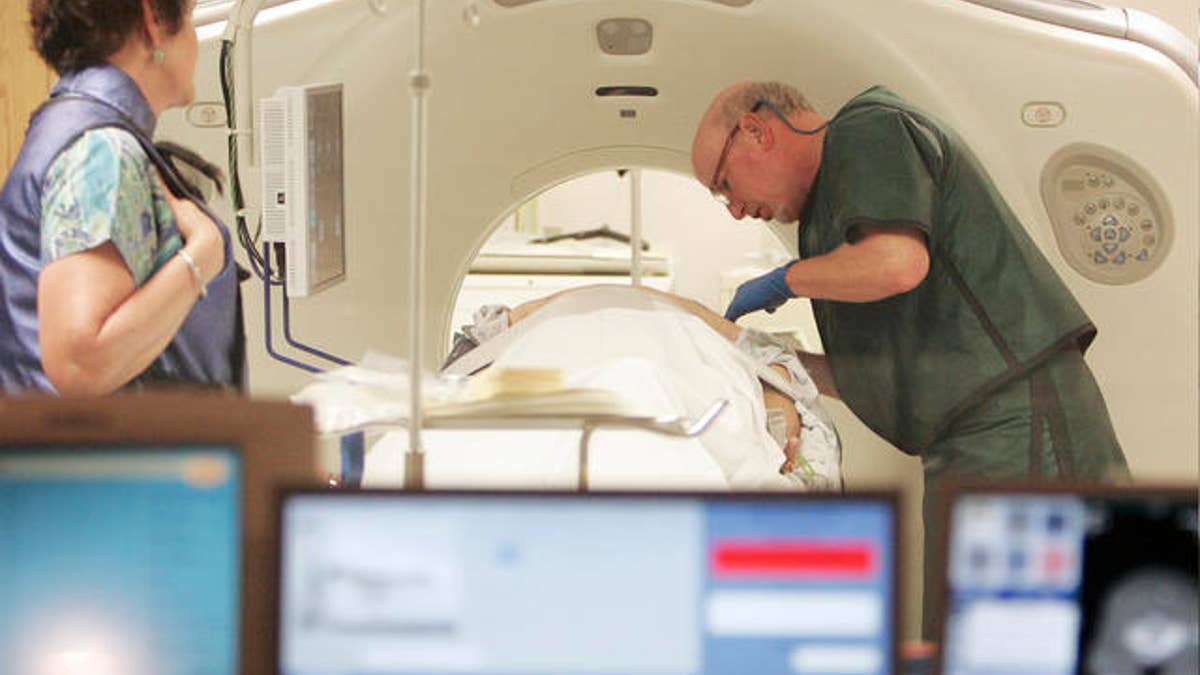
In this photo taken Thursday, June 3, 2010, Dr. Steven Birnbaum works a CT scanner with a patient at Southern New Hampshire Medical Center in Nashua, N.H. (AP Photo/Jim Cole) (AP)
Emergency rooms across the U.S. have seen a steep increase in CT scans of kids presenting with belly ache, while the appendicitis rate hasn't budged, new research shows.
The x-ray-based scans offer doctors a high-resolution peek into the body, but their growing popularity has been trailed by concerns over cancer risks down the road.
The new findings, out Monday in the journal Pediatrics, show CT scans in children with abdominal pain rose from less than one percent to more than 15 percent between 1998 and 2008.
"That is basically saying for every six or seven kids that go to the ER for belly ache, one is going to get a CT scan," Dr. Jahan Fahimi, who led the new work, told Reuters Health.
"There have been a lot of studies showing we use CT scans a lot more," he said, "but it's unclear whether we are actually making a significant impact on the care we provide."
It's estimated that getting two or three scans - variously known as CT, CAT or computed tomography scans - can damage cells enough to raise a person's cancer risk, particularly in children. But the extra risk is still very small from an individual's perspective.
"I tell my patients that the CAT scan I do today has a chance of causing cancer at some point down the road," said Fahimi, an emergency physician at the University of California, San Francisco. "That risk may be one in 500, it may be one in 1,000, but it's not zero."
CT scans typically cost between a few and several hundred dollars.
Based on a large national database, Fahimi and his colleagues found the number of children showing up with belly ache at ERs held steady at around six percent; the rate of diagnosed appendicitis - the major concern in such cases - fluctuated between two and eight percent without a clear pattern.
The use of other kinds of medical imaging, such as traditional x-rays and ultrasound, also didn't change.
"The only thing that has changed is CAT scans have gone up," said Fahimi, also of Highland Hospital in Oakland, California. "There is probably some benefit to it, but I don't know if that benefit tracks with the risk."
Dr. Brigitte Baumann, an emergency physician at Cooper University Hospital in Camden, New Jersey, said she was not surprised by the findings.
"The rate of CTs that we are doing at this point is clearly very high and it is concerning," said Baumann, who was not involved in the new work. "It sort of is a one-stop-shopping imaging modality."
Whether or not it makes sense to use CT imaging depends on the specific case, Baumann and Fahimi agreed.
Both said ultrasound, which doesn't carry cancer risks, is often the better alternative. But it, too, has its limitations, such as being operator-dependent and often not available around the clock.
The study also showed black children and uninsured were less likely to get a CT scan for belly aches. That's concerning, said Fahimi, but "you can't really say if it's a good thing or a bad thing," given the unclear risk-benefit balance of the technology.
Fahimi said the scan's popularity could have something to do with doctors trying to guard themselves against malpractice lawsuits.
"A missed appendicitis is one of the top three reasons why emergency physicians will get sued," he told Reuters Health.
Baumann added that doctors might also be less inclined to do surgery today if they aren't certain it's appendicitis.
So what should parents do with all that uncertainty about risks and benefits? Fahimi said that before doing a CT scan, he often suggests waiting four to eight hours to see if the child gets better on its own, unless it looks really sick.
"I think it's fairly safe to wait if the pain is not so severe," he said.
